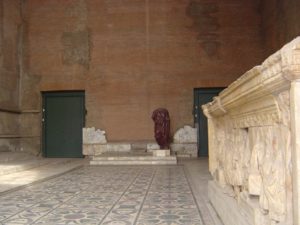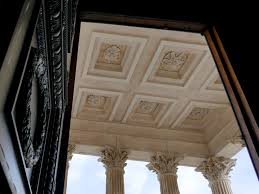Ancient Roman Senate House Interior: The central floor is paved with panels of opus sectile, in which porphyry and serpentine figure largely. To either side are three broad low marble-faced steps to keep the curule chairs of the more notable senators, the top step broader than the others for the senators who stood.

It is from these broad steps that senators would vote their ayes and nays by stepping to the left or right of the building. At the far end, between the doors mentioned above, is a low dais of two marble steps about twelve feet square for the presiding magistrate.
Roman Senate House Interior
Along each side wall is a gray marble wainscoting finished with a molding, above which were serpentine, porphyry and marble panels rhythmically placed with only the interruption of three widely spaced niches or doors to break the continual pattern. The center niche carries a segmental pediment, while the others hold triangular marble pediments with a flat head. These seem to have had rich architectural frames.

Each niche had paired mantle brackets holding which must have held alabaster Corinthian colonnettes. The marble facing of the internal walls was stripped around 1550 by Cardinal du Bellay and nothing remains of the decoration on the upper walls.
Roman senate building interior
The marble paneling showed a need to carry a horizontal plane. Above them and occasionally interrupted by the tips of the pediments was a long cornice. The next band carried tall gray rectangular panels that were only broken by mosaic lozenges and smaller rectangles.
The last two bands consisted of uninterrupted work. The first was long white rectangular panels and the final height looked to be all cream stucco. The vaulted ceiling was made with heavily gilt Lacunaria consisting of square coffers set with copper-looking discs in the center and a copper trim.

Roman Painting
Augustus placed two paintings inside the Curia. The first painting came from Asia by Silanus that Nicias of Athens painted. It presented Nemea seated on a lion holding a palm-branch in her hand and standing at her side an old man leaning on a stick and with a picture of a two-horse chariot hung up over his head, on which the inscription said it was an encaustic design.
The second painting, by Philocares, presented Glaucio and his son Aristippus with an eagle soaring above holding a snake within its claws.
Subsequent Additions
Initially, the architectural ornament must have seemed only a minor expression of the building’s power, yet when compared with other structures within the Roman Forum, its simplicity inevitably recalled the chaste, classicizing forms that characterized the Senate, itself.
What was the Curia Julia used for
Although the profiles of the cornice are similar to temples such as Vespasian and Saturn, the ornamentation was considerably more austere. However, the Curia Julia, as it was now called, maintained a similar structure of the old Curia Hostilia, and it was partially burned during the fire of Carinus of 283 AD.

Repaired/reconstructed Roman Senate House Interior
In Roman Senate House Interior work, Over time it was slowly repaired and reconstructed in which we see today, especially under Diocletian around 303 AD. It is this restoration that we see today. The Curia was converted to use as the church of S. Adriano under Honorius I (625-638 AD).
Borromini removed, restored, and relocated the bronze doors in the seventeenth century to serve the church of S. Giovanni in Laterano. At that time several coins were found between the plates, including one of Domitian. In 1935-1938 S. Adriano was deconsecrated and the Curia was restored to its ancient form. It is now used for the mounting of archaeological exhibitions of a temporary nature.
Curia Proper
In the Curia proper, the height of the façade indicated the relative importance of this building to the entire Roman Forum. Its simple proportions and columns evoked a sense of order and scale sustained by restrained power.

The richness of the architectural materials also ensured the same effect. The expensive marbles and paintings that ornamented the hall were unmistakable signs of an overwhelming imperial need to promote the Curia as the center of the Roman World.
Artistic Symbols
All the visible artistic symbols commemorated the Roman military prowess. Confiscated paintings and statues of Victory possibly stood inside the Curia. Acroterion warriors on the roof with another Victory were easily seen by onlookers. The frieze clearly stated Imperator Augustus to remind the Romans that an emperor existed. The Curia’s multiple images everywhere confronted the visitor.

The Romans’ loyalty to the Empire was strengthened, and they understood the Curia’s central principles and power on which the Roman Forum had been established. This was the building where all senatorial laws were passed and where even the emperor must occasionally enter to legitimize himself to the Roman people.



